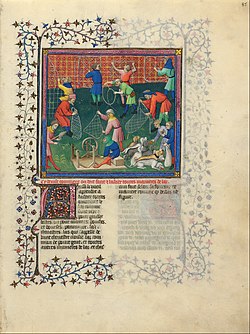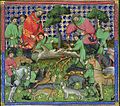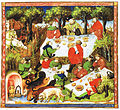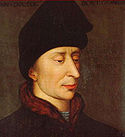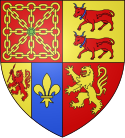Livre de chasse
Le Livre de chasse est un livre de vénerie médiévale composé entre 1387 et 1389 par Gaston Fébus (Gaston III de Foix-Béarn, 1331-1391), comte de Foix et vicomte de Béarn, dit Fébus, et dédié à Philippe le Hardi, duc de Bourgogne.
Il a été considéré comme un ouvrage de référence jusqu'au XIXe siècle, de nombreux exemplaires enluminés subsistant.
Histoire
Origines de l’œuvre
Gaston III, comte de Foix (1331–1391), surnommé Fébus du fait de sa chevelure dorée ou de sa beauté, écrivit ce livre de chasse tard dans sa vie (1387–89), partageant ses connaissances dans un domaine où il se déclarait maître, « au contraire de ses deux autres plaisirs dans la vie : le combat et l'amour. »
L’œuvre, dédié à son compagnon de chasse et au combat Philippe le Hardi, duc de Bourgogne, comprend quatre livres:
- Sur les Bêtes Douces et Sauvages,
- Sur la Nature et les Soins aux Chiens,
- Sur les Instructions pour Chasser avec des Chiens,
- Sur la Chasse avec des Pièges, des Collets et des Arbalètes.
Rééditions
En plus de versions manuscrites, l’œuvre a été imprimée trois fois au cours du XVIe siècle (une première fois autour de 1500, puis à deux reprises autour de 1507) et a également connu de nombreuses rééditions modernes depuis 1854, une des plus récentes étant Das Jagdbuch des Mittelalters. Ms. fr. 616 der Bibliothèque nationale in Paris, éditée par W. Schlag et Marcel Thomas (Glanzlichter der Buchkunst 4; Graz, 1994; réédité en 2001).
L'ouvrage a été édité en quasi-original par Moleiro Editor en 2016.
Dans plusieurs rééditions, l'ouvrage inclut à la fin le poème Le Romant des Deduis de Gace de la Bigne, composé alors qu'il était chapelain à la cour des Rois de France, notamment dans l'édition : Phebus, des deduiz de la chasse des bestes sauvaiges et des oyseaux de proye : Suivi du Poème de Gace de la Bigne sur la chasse, Antoine Vérard, (BNF 30485679, lire en ligne). Le lien lire en ligne renvoie directement vers le poème de Gace de la Bigne situé à la fin, après l'ouvrage de Gaston Fébus[1].
Manuscrits

La liste des manuscrits du livre de chasse encore existants inclut les suivants[2]:
- MS IV 1050 – Bibliothèque royale de Belgique, Bruxelles.
- Typ 130 – Bibliothèque de Houghton, université Harvard, Cambridge
- Ms. 343 – Bibliothèque Inguimbertine, Carpentras.
- Ms. 367 (480) – Bibliothèque et Archives du château de Chantilly, Chantilly.
- Oc. 61 – Bibliothèque d'État et universitaire de Saxe, Dresde.
- Ms. 169 – Bibliothèque de Genève.
- Hunter 385 (V.2.5) – Bibliothèque de l'université de Glasgow, Glasgow.
- Rastatt 124 – Badische Landesbibliothek, Karlsruhe.
- Add. 27699 – British Library, Londres.
- MS. 27 – J. Paul Getty Museum, Los Angeles.
- Ms. 765 – Bibliothèque municipale de Lyon.
- Ms. 22 – Musée Thomas-Dobrée, Nantes.
- MS M. 1044 – Morgan Library, New York.
- Français 616, Français 617, Français 618, Français 619, Français 620, Français 1289, Français 1291, Français 1293, Français 1294, Français 1295, Français 12398 – Bibliothèque nationale de France, Dépt. des Manuscrits, Paris.
- Ms. 6529 – Musée national du château de Pau, Pau.
- HB XI 34a – Württembergische Landesbibliothek, Stuttgart.
- J.a.VIII.6 – Archives d'État de Turin, Turin.
- Ms. 841 – Bibliothèque municipale de Tours
- Reginensi latini 1323, Reginensi latini 1326, Reginensi latini 1331 – Bibliothèque du Vatican, Cité du Vatican.
Enluminures du Livre de chasse
Notes et références
- folios k vi à z iv (Thiébaud. Bibliographie des ouvrages français sur la chasse, colonnes 728-729).
- Arlima: archives de littérature du moyen âge. Accessed 1 November 2015.
Voir aussi
Liens externes
- Manuscrits enluminés du Livre de chasse en ligne
-
(fr) Deux expositions virtuelles de la Bibliothèque nationale de France concernant deux des plus beaux manuscrits conservés du Livre de chasse, les manuscrits Français 619 et 616.
- Le Livre de chasse de Fébus (série « Expositions virtuelles »)
- Le Livre de chasse de Fébus (série « Dossiers pédagogiques »)
- (en) Enluminures en ligne du manuscrit n° 27 conservé à Los Angeles au J. Paul Getty Museum, anciennement possédé par la Bibliothèque nationale de Russie, Saint-Pétersbourg (Leningrad), fr. F.v.X.1
-
(en) Enluminures en ligne du manuscrit n° 1044 conservé à New York à la Pierpont Morgan Library
- Accessible en ligne via le projet CORSAIR, en fonction durant les heures ouvrables (horaire de New York).
- Autres ressources en ligne
- (fr) Archives de littérature du Moyen Âge (ARLIMA), Bibliographie détaillée concernant le Livre de chasse : liste détaillée des manuscrits existants, des éditions du texte et des études
- Histoire d'un exemplaire du Livre de chasse échappé à l'incendie de Neuilly
- Lavallée, Journal des chasseurs, p. 315-317, Douzième année, 1848 Texte (il doit s'agir du manuscrit Français 616 de la BnF)
Médias utilisés sur cette page
Auteur/Créateur: Léon Bonnat (1833-1922), Licence: CC-BY-SA-3.0
Victor Hugo (26 February 1802 - 22 May 1885).
(c) I, Peter Potrowl, CC BY 3.0
Cette image vectorielle non W3C-spécifiée a été créée avec Inkscape .
Gaston Phoebus (1331–1391) Ex Libris of King Ferdinand II of Aragon and Queen Isabella of Spain Livre de la chasse, in French France, Paris ca. 1407 15 1/4 x 11 1/4 inches (385 x 287 mm) Bequest of Clara S. Peck, 1983 MS M. 1044
Page description: The Morgan Phoebus, a book fit for a king, was given to Ferdinand and Isabella a few years before 1492, when they retook Granada and added the pomegranate (its symbol) to their coat of arms. As a sign of their ownership, they commissioned a Castilian artist connected with Juan de Carrion to add this splendid ex libris to the manuscript. The emblems in the inner border reflect the monarchs' conjugal bond, for each used the one belonging to the initial of the other: Ferdinand, the yoke (iugo, the I) and Isabella, the arrow (flecha, the F). The animals in the outer border offer a prelude to the manuscript, as they are quoted from its miniatures.
About this exhibition: The Morgan's lavishly illustrated Phoebus was made in Paris about 1407, as was one in the Bibliothèque nationale de France. Of the forty-six surviving Phoebus manuscripts, these two are the most magnificent. This presentation includes forty-five images from Phoebus and five other images depicting the noble hunt.
Hunting was an important part of medieval life; kings and noblemen were expected to excel and take pleasure in the pursuit. Some famous hunters wrote books on the subject, whereas others collected and commissioned them. Three of the most popular French treatises were written during the fourteenth century, but others were also written in Spanish, English, and German.
Gaston III, Count of Foix (1331–1391), called Phoebus on account of his golden hair or handsome features, wrote his hunting book late in life (1387–89), sharing his knowledge in a field in which he claimed supremacy, unlike in his two other pleasures in life, arms and love. The work, dedicated to his fellow hunter and warrior Philip the Bold (1342–1404), Duke of Burgundy, comprises four books: On Gentle and Wild Beasts, On the Nature and Care of Dogs, On Instructions for Hunting with Dogs, and On Hunting with Traps, Snares, and Crossbow.
This manuscript may have been commissioned by Philip the Bold's son, John the Fearless (1371–1419), as a gift for Louis d'Orléans (1372–1407). If so, it would date before 23 November 1407, when Louis was assassinated in Paris. Years later it fell into the hands of a duke of Brittany, probably Francis II (r. 1458–88), who added his arms on folio 4. Before 1492 it was acquired by Ferdinand and Isabella of Spain, who added their magnificent full-page arms to the book (folio 1v).
In 1928 Dr. Rosenbach of Philadelphia bought the book from Thomas Fenwick, heir of Sir Thomas Phillipps, the "vellomaniac,", for £10,000 and offered it to J. P. Morgan, Jr., at the special price of $165,000, which Morgan declined. There is no evidence that Fenwick ever offered it to Pierpont Morgan, but Morgan might well have been interested. Morgan was a breeder of collies, and in 1893 he entered ten collies in the Westminster Kennel Club Dog Show at Madison Square Garden, winning the silver cup for the best collie, Sefton Hero.
The book remained unsold until 1943, when Rosenbach sold it to Clara S. Peck, who was a breeder and rider of horses, for $65,000. Three years later she lent it to the Morgan for an exhibition on Sports and Pastime. Thereafter, through the continued efforts of the Morgan's first three directors, Peck decided to bequeath it to the Morgan, which she did on 20 April 1983.